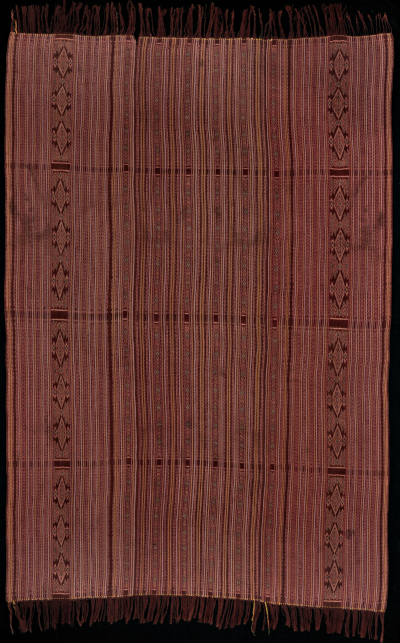| |
 
 | | | |
150 Timor, West Timor
Bete krao (men's wrap)  
| | Locale: | Manulea (Malaka Tengah), Atoin Meto people. | | Period: | 1970 | | Yarn: | Cotton, commercial, fine, double-ply | | Technique: | Warp ikat | | Panels: | 3 | | Size: | 64 x 168 cm (2' 1" x 5' 6") LW: 2.62 | | Weight: | 905 g (31.9 oz), 842 g/m2 (2.76 oz/ft2) | | Design: | Two main ikat bands with numerous fine bands of dot, dash and �squiggle, and accents in a greenish light blue. The main motif is makaif, which represents relations to the ancestors. Very fine accent stripes in pre-dyed thread in a variety of colours. Manulea striped ikat menís cloths are a classic type of Timor textile, prized for their unusually detailed, sharply defined ikat. Their use of green is a distinctive characteristic of Manulea weaving. | | Comment: | [PHOTOGRAPHY PROVISIONAL - Cloth has since been cleaned and is free of smudges] Excellent weaving, fine drawing, soft feeling due to the very fine yarn - probably hand spun as the region is known for its very fine wheel spun yarn. Manulea is the informal name for a group of districts that form an Atoni area within the otherwise Tetun Malaka, which is the heartland of the Tetun people who arrived in Timor in the 14th c. It has a distinctive textile tradition that reflects Manuleaís political separation from the dominant central and eastern Timor culture since at least the mid 18th c, the trademark of these textiles being their rich red-brown color (also found in other Atoni areas) and very fine weaving. Very similar in style to beti from nearby Biboki, but those from Manulea show finer patterning. Manulea pieces are so fine that from a short distance their intricacy is no longer discernible while Biboki pieces are simpler and bolder. They appear to be rarer than their Biboki counterparts, perhaps (as Mac Darrell Serizawa suggests) because one needs to see them up close to appreciate the intricacy of the patterns and the fine quality of the ikat work. Twisted fringes. | | Background: | Chapters on Timor and West Timor. | | Exhibited: | .
Timor: Totems and Tokens, Museu do Oriente, Lisbon, 2019/20. | | Compare: | 176 177 172 216 224 | | Sources: | Nearly identical to examplefrom same period in Fowler Museum depicted in Hamilton and Barrkman, Textiles of Timor, Fig. 7.34. Very similar to beti in Yeager and Jacobson, Textiles of Western Timor, Plates 224 and detail on 226. Similar to Specimen in The Textile Museum, Washington, Acc. nr. 1982.14.1. | | |

©Peter ten Hoopen, 2025
All rights reserved.
|
|


